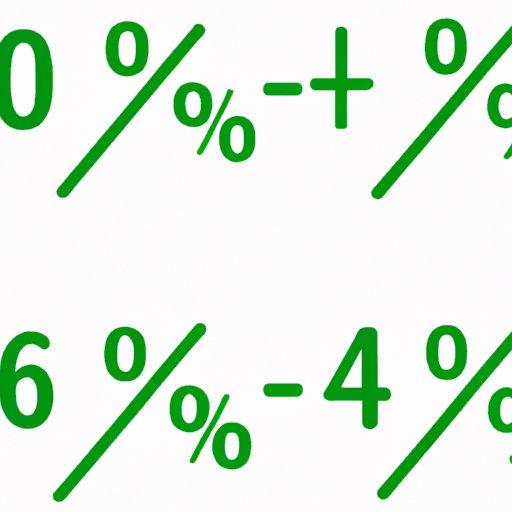
I. Introduction
Knowing how to calculate percent decrease is an essential skill in everyday life, whether you’re tracking your savings, budgeting for expenses, or monitoring your business’s growth. Understanding percent decrease can help you make informed decisions about your personal and professional finances. In this article, we will provide a step-by-step guide to calculating percent decrease, give real-world examples, and explore common mistakes to avoid.
II. A Step-by-Step Guide to Calculating Percent Decrease
The formula for calculating percent decrease is:
Percent Decrease = ((Original Value – New Value) / Original Value) x 100
To calculate percent decrease, you need to follow these simple steps:
- Calculate the difference between the original value and the new value.
- Divide the difference by the original value.
- Multiply the result by 100 to get the percentage.
Let’s say you bought a pair of shoes for $75, but the price dropped to $60. To calculate the percent decrease:
- The difference between the original value and the new value is $75 – $60 = $15.
- Divide $15 by $75 to get 0.2.
- Multiply 0.2 by 100 to get 20%. Therefore, the percent decrease is 20%.
III. Real-World Examples of Percent Decrease
Let’s discuss some familiar scenarios that involve percent decrease:
- A store is offering a discount of 15% on a $100 dress. How much will you save?
- The value of a car depreciates by 10% every year. If the original value of a car was $20,000, what will be its value after two years?
- During a sale, the price of a phone decreased from $500 to $400. What is the percent decrease in price?
To calculate the percent decrease in these scenarios, use the formula mentioned earlier:
Percent Decrease = ((Original Value – New Value) / Original Value) x 100
For example, in the first scenario, you can calculate the percent decrease as follows:
- The difference between the original value and the new value is $100 – ($100 x 15/100) = $85.
- Divide $15 by $100 to get 0.15.
- Multiply 0.15 by 100 to get 15%. Therefore, the percent decrease is 15%.
IV. Common Mistakes to Avoid When Calculating Percent Decrease
Here are some common errors people make when calculating percent decrease:
- Using the wrong formula: Make sure to use the correct formula to avoid wrong results.
- Switching the order of the values: Always subtract the new value from the original value to get a negative result.
- Confusing percent decrease with percent difference: Percent decrease is the reduction in value from the original value. Percent difference is the difference between two values, expressed as a percentage of one of the values.
To avoid these mistakes, double-check your calculations, and use a calculator if necessary.
V. Exploring the Math Behind Percent Decrease
The math behind percent decrease is based on the concept of fractions and percentages. The formula for percent decrease is an algebraic expression that involves two values and division.
For example, if your original value is 100 and the new value is 80, the percent decrease is:
Percent Decrease = ((100 – 80) / 100) x 100 = 20%
This means that there was a 20% reduction in the original value, which is equal to 1/5 of the original value.
VI. Visual Aids for Calculating Percent Decrease
Visual aids like graphs, charts, and diagrams can be helpful when calculating percent decrease. These tools can visually depict the change in values and make it easier to understand the calculations.
Consider the example of a stock that has decreased in value from $30 per share to $24 per share. To calculate the percent decrease, you can use a line graph to plot the values of the stock over time. The graph will show a downward trend and help you to visualize the change in value.
VII. Applications of Percent Decrease in Business and Finance
Percent decrease is widely used in business and finance to track performance, analyze trends, and predict future outcomes. Here are some examples of how percent decrease can be used in these fields:
- Calculating the monthly percentage decrease in sales to determine its effect on revenue.
- Analysing the percent decrease in stock prices to predict market trends and investor sentiment.
- Determining the percent decrease in operating expenses to identify areas for cost-saving initiatives.
VIII. Ways to Calculate Percent Decrease Using Different Methods
There are several ways to calculate percent decrease, including:
- Dividing the difference between the original value and the new value by the original value.
- Multiplying the difference between the original value and the new value by 100 and dividing by the original value.
- Using the percentage change formula: Percent Change = ((New Value – Old Value) / Old Value) x 100.
Each method has its advantages and disadvantages, and the choice of the method depends on the context and purpose of the calculation.
IX. Conclusion
Calculating percent decrease is a useful skill that can help you make informed financial decisions in everyday life. Understanding the formula, avoiding common mistakes, and applying it to real-world scenarios are essential steps to mastering percent decrease calculations. Whether you’re managing your personal finances or analyzing business performance, percent decrease is a valuable tool that can help you stay on top of your game.




